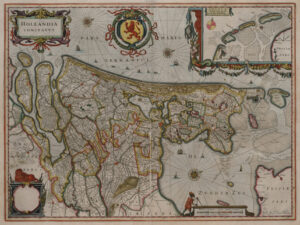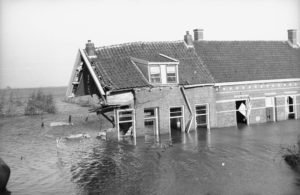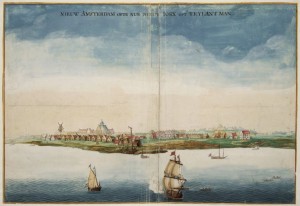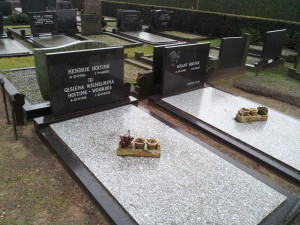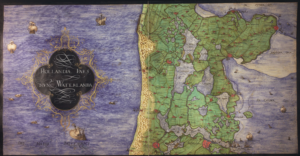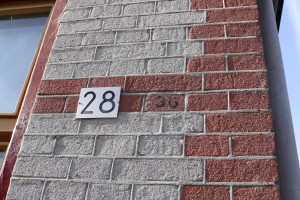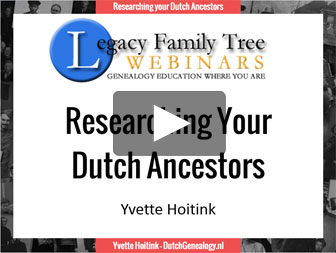In 1659, the famous mapmaker Joan Blaeu published his world atlas Tooneel des Aardrycks [Display of the Realm of Earth]. The archives in Leiden have made their atlas available online. This week we are looking at his map of the county of Holland. The map shows several lakes have already been turned into polders, such as the Beemster, Purmer, Schermer, and Wormer. The Haarlemmermeer was still a lake. The largest city on the map if Amsterdam, connected to the Zuyder Zee [South Sea, a bay of the … [Read more...]
Dutch Genealogy News for October 2024
Here is an overview of the new sources, projects, and other news from the past month. Sources The De Hullu Collection at the Zeeuws Archief has been largely digitized. De. J. de Hullu made many scientific notes and transcripts, mainly regarding the history of the western part of Zeeuws-Vlaanderen. His collection is of special importance since many original records from the area were lost in World War II. Many Noord-Brabant death records 1971-1973 have been scanned and indexed and are … [Read more...]
Map of the Week – Connections in Utrecht, circa 1919
This map, created shortly after the end of World War I, shows the different connections in the province of Utrecht The legend identifies the different types of lines on the map: railroads tramways paved roads gravel roads provincial border dikes hills. The 1800s saw a tremendous increase in infrastructure. This map captures the rail and tram infrastructure at its height. In the course of the 1900s, many rail and tram lines were abolished as cars and transport by road … [Read more...]
Named Fellow for the New Netherland Settlers project
The Gladys Krieble Delmas Foundation has awarded a $12,000 grant to the New York Genealogical & Biographical Society to support a Fellow for their New Netherland Settlers project. I am honored to announce I have been named in that position. As a Fellow, I will research underrepresented and underexamined populations within New Netherland such as free and enslaved individuals, Indigenous people, and the many others who contributed to the diverse, multilingual dynamics of New … [Read more...]
Map of the Week – Overijssel, 1680
This map of Overijssel was originally created by Nicolaas ten Have and printed by Frederik de Wit in 1680. Such maps can be useful to understand the location where your ancestor lived. It shows the major roads and rivers. It also shows the jurisdictions, in this case the Land van Vollenhove in blue, Salland in yellow, and Twente in pink. The map shows some local features like noble manors, castles, water mills, and quarries. … [Read more...]
Dutch term – Kerkdienst
A kerkdienst is a church service. In most places in the Netherlands, churches are no more than 10 km (6 miles) apart, so anyone can walk to church within an hour (two if the roads are muddy). In the image below we see a group of people leaving a church, drawn around 1654. At that time, churches were not heated. We can tell this service took place during the colder months. Several women have their hands in muffs, and some are carrying a little stove which would have held some hot coals to … [Read more...]
Map of the Week – Leiden, 1574
This week we are looking at a map of Leiden from the atlas Civitates Orbis Terrarum by Braun and Hogenberg. The map dates from 1574, during the Eighty Years' War or the Dutch Revolt, whereby the Netherlands fought for independence from the Habsburg Empire, ruled by King Philip II of Spain. 1574 is a key year in Leiden's history. The city was besieged by Spanish troops for months, but the townsfolk refused to surrender despite food shortages. They managed to get a message out to William … [Read more...]
5 Alternatives for Non-Public Birth, Marriage, or Death Records
In the Netherlands, vital records do not immediately become public but remain closed for a certain period: Birth records: 100 years Marriage records: 75 years Death records: 50 years. The records become public on 1 January of the year following the embargo period. As I described in a previous post, it may be possible to obtain copies of non-pubic records with permission of the person involved or with proof of their death. In this post, I will describe some alternative sources for … [Read more...]
Map of the week – Waterland, circa 1573
Around 1573, cartographer Christiaan sGroten created an atlas of the Netherlands and Germany for the King of Spain. At this time, the Netherlands were part of the Habsburg empire, headed by King Philip II of Spain. The Dutch Revolt had started several years earlier and the Spanish king needed maps for strategic purposes and commissioned the atlas. The atlas has been digitized and is available at the Royal Library of Belgium. The map we are looking at this week shows a part of the province of … [Read more...]
Dutch term – Omnummeren
Omnummeren means to renumber. In the past, addresses often changed from one census/population register to the next. The houses would be omgenummerd; renumbered. This can make it difficult to find the modern locations of historical addresses. See tips for finding the address where your ancestors lived for some ideas. Some archives have omnummerlijsten (renumber lists) or omnummerregisters (renumber registers), either created in the past and part of their records, or created in the modern … [Read more...]
